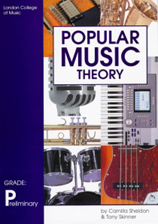All scales and key signatures are fully illustrated and explained in the grade handbooks - which also contain sample questions and answers. Find out more
Scales for Preliminary Grade Exam:
All chords are fully illustrated and explained in the grade handbooks - which also contain sample questions and answers. Find out more
Chords for Preliminary Grade Exam:
Illustrations and explanations of all relevant aspects of rhythm notation are shown in the grade handbooks - which also contain sample questions and answers. Find out more
Rhythm Notation for Preliminary Grade Exam:
This is the first book in the highly regarded 7 part series of Popular Music Theory handbooks. A perfect introduction to popular music theory this book will help you to improve your musicianship whether or not you intend to take the LCM examination.
All topics are for the exam are covered in a way that is directly applies to the music you play, making music theory both relevant and practical.
You’ll learn about keys, chords, scales, rhythms, harmony and improvisation as well as developing a broad musical knowledge (including instrumentation, musical terms and the history of popular music).
